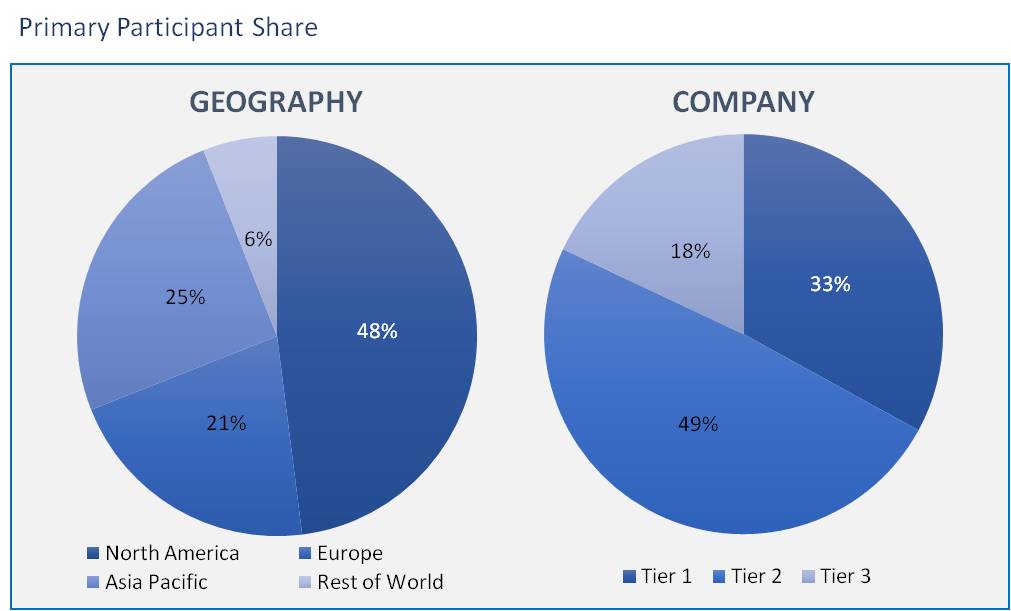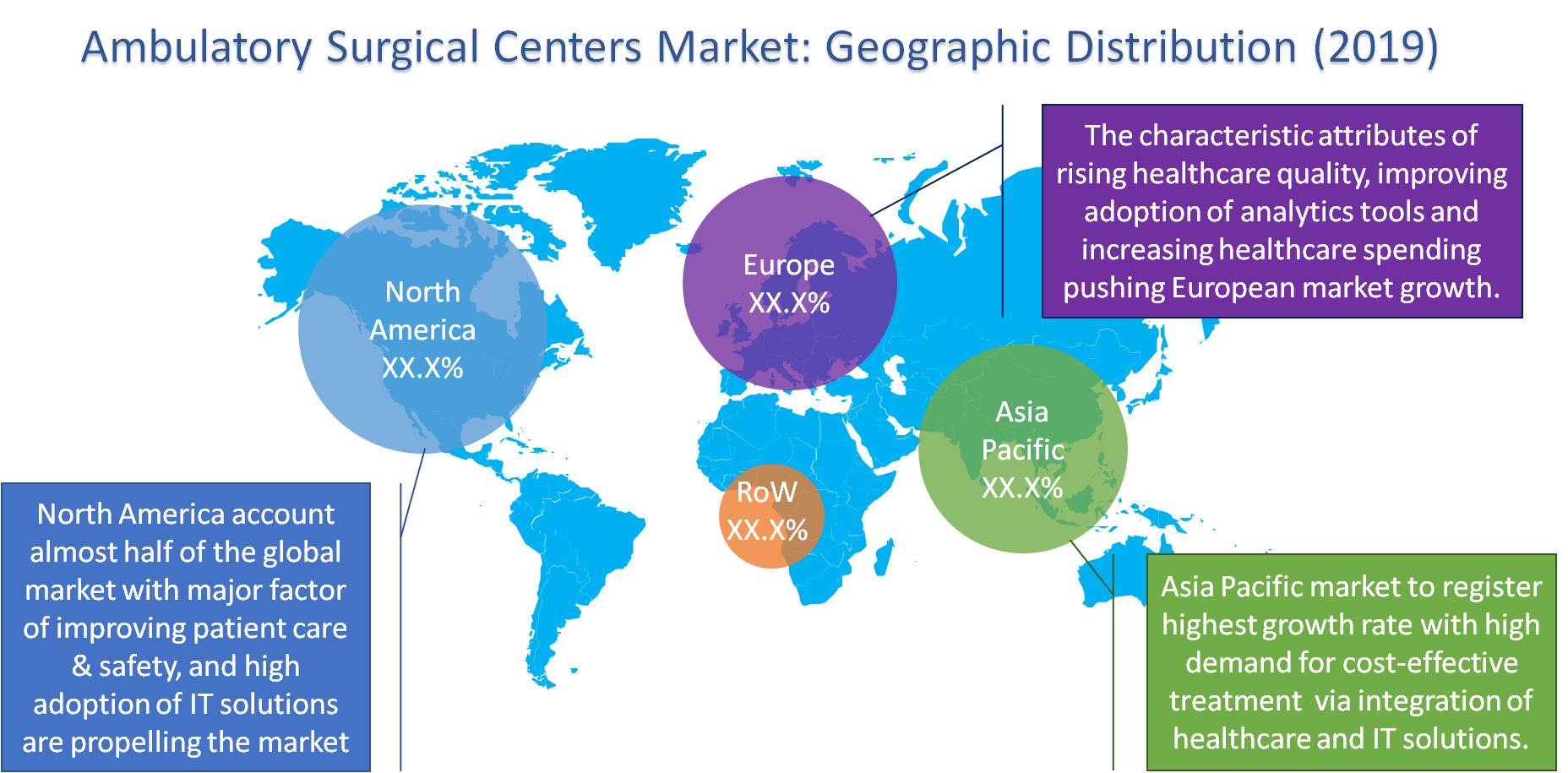
Ambulatory Surgery Centers Market by Product (Clinical It Solutions, Non-Clinical Healthcare It Solutions, And HCIT Outsourcing Services), By Component (Services, Software, and Hardware), By Specialty Type (Single, Multi-specialty), and By Geography – Global Drivers, Restraints, Opportunities, Trends, and Forecast up to 2026
- August, 2020
- Domain: Healthcare - Health and Hygiene
- Get Free 10% Customization in this Report
An ambulatory surgery center is defined as a unique entity that primarily provides outpatient procedures to those types of patients who do not require an overnight stay after the surgery. ASCs are outpatient surgery centers where surgeries are performed on the same day of admission of patients without any kind of need for an overnight stay. In addition to the ASCs, hospital outpatient departments (HOPDs) also perform outpatient surgical procedures. These centers offer all diagnostic and preventive procedures. The ambulatory surgical centers are highly efficient, and they perform same-day surgeries such as gall bladder removal, small join repair cataract surgery, abdominal hernia repair, skin therapy, and others.
Research Methodology:

The estimated market value of Ambulatory Surgery Centers in 2020 is $2.29 billion. There are three important factors which are the driving wheels behind the growth of Ambulatory Surgical Centers market:
- A rising number of Ambulatory Surgical Centers
- An absolute need to curtail escalating healthcare costs
- Availability of minimally invasive treatment
Growth in the global ambulatory surgical centers market is largely a result of growing focus on confinement of healthcare costs and increased healthcare spending on ASCs. ASCs are primarily focused on increasing the number of facilities and types of procedures performed. An increasing variety of procedures provided by ASCs with greater reimbursement benefits are fuelling market growth. Across worldwide, ASCs are continuously making attempts to extend their range of services to increase patient served and thereby increasing its revenues. The growth of procedures in ASC is likely to beat hospital outpatient surgical growth.

Innovative and technology advances increment the methodology that can be securely performed on outpatient treatment. For orthopedic specialists, ASCs are regularly increasingly helpful, progressively proficient, and adaptable to their necessities. Numerous musculoskeletal methodologies are profoundly specialized and concentrated, and ASCs permit an orthopedic specialist the chance to perform out these perplexing techniques more proficiently than other types of treatment methods. In the US, there are fewer freestanding surgery centers being built, while more centers have been built within a larger premise that offers a wider array of ambulatory care services. ASCs are being opened within such facilities which drive the market growth
The market of Ambulatory surgical centers is segmented into three types:
- Services
- Software
- Hardware
With the introduction of complex software, the services need for integration and interoperability of software has increased, pushing the services segment for the larger market share in 2019. There has been a growing demand for outsourcing of various healthcare processes, which increases the demand for healthcare services management services.
Analyzing based on specialty, the Ambulatory surgical centers market is divided into
- Single Specality
- Multi Specality
In 2019, the multi-specialty segment of ASCs accounted for the largest share. The large share of multi-specialty can be accounted for the multiple numbers of surgical procedures that are carried out in these facilities and the presence of reimbursement for these procedures.
Analyzing on the basis of product, the Ambulatory surgical centers market is divided into
- Clinical It Solutions
- EHR
- Practice Management Software
- Medical Image Analysis
- E-Prescribing
- Telehealth Solutions
- Surgical Planning Software
- Health Integration Solution
- Population Health Management Solution
- Other Clinical Solutions
- Non-Clinical Healthcare IT Solutions
- Revenue Cycle Management
- Supply Chain Management Solutions
- Healthcare Anaytics Solutions
- Healthcare Interoperability Solutions
- Healthcare Quality Management Solutions
- Other Non-Clinincal Solutions
- HCIT Outsourcing Services
The factors which are the drivers of the market growth of ambulatory surgical centers are an increase in the number of surgeries, a rise in the incidence of chronic diseases, and growth in the geriatric population. In addition to the above-mentioned factors, the advancements in technology, and surging demand for minimally invasive surgeries are fuelling the growth of the ambulatory surgical Centre market. This domain is believed to have a dynamic and very cautious nature.
Few major players in the domain of Ambulatory Surgical Centers are McKesson Corporation, Cerner Corporation, GE Healthcare, Philips Healthcare, Allscripts Healthcare Solutions, Inc., Optum, Epic Systems Corporation, Advanced Data Systems Corporation, Epic Systems Corporation, NextGen Healthcare, CureMD, HST Pathways, and Surgical Information Systems.
The growing burden of cutting down of increasing healthcare costs, move from inpatient to outpatient surgical procedures, and rising need of IT solutions such as mhealth, telehealth, and remote monitoring of the patient for better management create the market opportunity for Ambulatory Surgical Centers vendors to fulfill both the residential as well as commercial demand
The above report will help in understanding the current market dynamics, changing needs, and innovations that would be required to augment the user experience.
- A quantitative analysis would be provided which would help the stakeholders while they decide to capitalize on the present market opportunities
- This extensive report would be the foundation for any research institute on the Ambulatory Surgical Centers, vendor capabilities, SWOT of the Ambulatory Surgical Centers and framework for data analysis for further advanced innovation
- This report briefly describes the factors which are driving the growth of Ambulatory Surgical Centers and the factors which are restricting the progress
- The key players of this market have been recognized, and then a competitive outlook has been prepared.
- The report contains insight regarding technological innovations and advanced solutions for the Ambulatory Surgical Centers
1. Executive Summary
2. Industry Outlook
2.1. Industry Overview
2.2. Industry Trends
3. Market Snapshot
3.1. Market Definition
3.2. Market Outlook
3.3. PEST Analysis
3.4. Porter Five Forces
3.5. Related Markets
4. Market Characterisitics
4.1. Market Evolution
4.2. Market Trends and Impact
4.3. Advantages/Disadvantages of Market
4.4. Regulatory Impact
4.5. Market Offerings
4.6. Market Segmentation
4.7. Market Dynamics
4.7.1. Drivers
4.7.2. Restraints
4.7.3. Opportunities
4.8. DRO - Impact Analysis
5. Products & services: Market Size & Analysis
5.1. Overview
5.2. Hcit Outsourcing Services
5.2.1. Population Health Management Solutions
5.2.2. Medical Image Analysis Solutions
5.2.3. e-prescribing Solutions
5.2.4. Practice Management Software
5.2.5. Surgical Planning Software
5.2.6. Telehealth Solutions
5.2.7. Healthcare Integration Solutions
5.2.8. Other Clinical Solutions
5.3. Non-Clinical Healthcare It Solutions
5.3.1. Revenue Cycle Management Solutions
5.3.2. Healthcare Analytics Solutions
5.3.3. Healthcare Quality Management Solutions
5.3.4. Healthcare Interoperability Solutions
5.3.5. Other Non-clinical Solutions
5.3.6. Other
6. Components: Market Size & Analysis
6.1. Overview
6.2. Services
6.3. Software
6.4. Hardware
7. Specialty: Market Size & Analysis
7.1. Overview
7.2. Single Specialty
7.3. Multi-specialty
8. Geography: Market Size & Analysis
8.1. Overview
8.2. North America
8.3. Europe
8.4. Asia Pacific
8.5. Rest of the World
9. Competitive Landscape
9.1. Competitor Comparison Analysis
9.2. Market Developments
9.2.1. Mergers and Acquisitions, Legal, Awards, Partnerships
9.2.2. Product Launches and execution
10. Vendor Profiles
10.1. Cerner Corporation
10.1.1. Overview
10.1.2. Product Offerings
10.1.3. Geographic Revenue
10.1.4. Business Units
10.1.5. Developments
10.1.6. Business Strategy
10.2. Allscripts Healthcare Solutions, Inc
10.2.1. Overview
10.2.2. Product Offerings
10.2.3. Geographic Revenue
10.2.4. Business Units
10.2.5. Developments
10.2.6. Business Strategy
10.3. Mckesson Corporation
10.3.1. Overview
10.3.2. Product Offerings
10.3.3. Geographic Revenue
10.3.4. Business Units
10.3.5. Developments
10.3.6. Business Strategy
10.4. Nextgen Healthcare
10.4.1. Overview
10.4.2. Product Offerings
10.4.3. Geographic Revenue
10.4.4. Business Units
10.4.5. Developments
10.4.6. Business Strategy
10.5. Epic Systems Corporation
10.5.1. Overview
10.5.2. Product Offerings
10.5.3. Geographic Revenue
10.5.4. Business Units
10.5.5. Developments
10.5.6. Business Strategy
10.6. Philips Healthcare
10.6.1. Overview
10.6.2. Product Offerings
10.6.3. Geographic Revenue
10.6.4. Business Units
10.6.5. Developments
10.6.6. Business Strategy
10.7. GE HEALTHCARE
10.7.1. Overview
10.7.2. Product Offerings
10.7.3. Geographic Revenue
10.7.4. Business Units
10.7.5. Developments
10.7.6. Business Strategy
10.8. Medical Information Technology, Inc
10.8.1. Overview
10.8.2. Product Offerings
10.8.3. Geographic Revenue
10.8.4. Business Units
10.8.5. Developments
10.8.6. Business Strategy
10.9. ECLINICAL WORKS
10.9.1. Overview
10.9.2. Product Offerings
10.9.3. Geographic Revenue
10.9.4. Business Units
10.9.5. Developments
10.9.6. Business Strategy
10.10. Novus International, Inc
10.10.1. Overview
10.10.2. Product Offerings
10.10.3. Geographic Revenue
10.10.4. Business Units
10.10.5. Developments
10.10.6. Business Strategy
11. Companies to Watch
11.1. Advanced Data Systems Corporation
11.1.1. Overview
11.1.2. Market
11.1.3. Business Strategy
11.2. OPTUM
11.2.1. Overview
11.2.2. Market
11.2.3. Business Strategy
11.3. CUREMD
11.3.1. Overview
11.3.2. Market
11.3.3. Business Strategy
11.4. HST PATHWAYS
11.4.1. Overview
11.4.2. Market
11.4.3. Business Strategy
11.5. SURGICAL INFORMATION SYSTEMS, LLC
11.5.1. Overview
11.5.2. Market
11.5.3. Business Strategy
11.6. WRS HEALTH
11.6.1. Overview
11.6.2. Market
11.6.3. Business Strategy
11.7. DAVLONG BUSINESS SOLUTIONS
11.7.1. Overview
11.7.2. Market
11.7.3. Business Strategy
11.8. COMPULINK HEALTHCARE SOLUTIONS
11.8.1. Overview
11.8.2. Market
11.8.3. Business Strategy
11.9. AMBLITEL
11.9.1. Overview
11.9.2. Market
11.9.3. Business Strategy
11.10. DRCHRONO
11.10.1. Overview
11.10.2. Market
11.10.3. Business Strategy
12. Analyst Opinion
13. Annexure
14. Annexure
14.1. Report Scope
14.2. Market Definitions
14.3. Research Methodology
14.3.1. Data Collation and In-house Estimation
14.3.2. Market Triangulation
14.3.3. Forecasting
14.4. Report Assumptions
14.5. Declarations
14.6. Stakeholders
14.7. Abbreviation
Research Framework
Infoholic research works on a holistic 360° approach in order to deliver high quality, validated and reliable information in our market reports. The Market estimation and forecasting involves following steps:
- Data Collation (Primary & Secondary)
- In-house Estimation (Based on proprietary data bases and Models)
- Market Triangulation
- Forecasting

Market related information is congregated from both primary and secondary sources.
Primary sources
involved participants from all global stakeholders such as Solution providers, service providers, Industry associations, thought leaders etc. across levels such as CXOs, VPs and managers. Plus, our in-house industry experts having decades of industry experience contribute their consulting and advisory services.
Secondary sources
include public sources such as regulatory frameworks, government IT spending, government demographic indicators, industry association statistics, and company publications along with paid sources such as Factiva, OneSource, Bloomberg among others.
